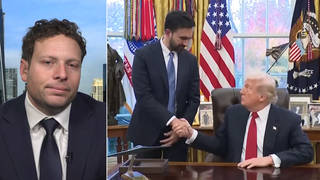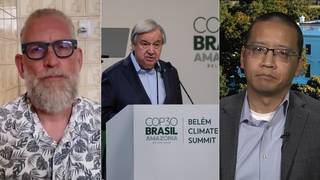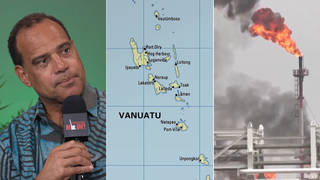
Guests
- David Helvargexecutive director of Blue Frontier, an ocean conservation organization.
Hurricane Harvey has already dumped more than 9 trillion gallons of water on Texas—enough water to fill the Great Salt Lake in Salt Lake City twice. Meteorologists project another 5 to 10 trillion gallons of water could be dumped on the region in coming days, potentially making this the worst flooding disaster in U.S. history. We speak with David Helvarg, executive director of Blue Frontier, an ocean conservation organization, about how climate change is fueling massive storms like Hurricane Harvey.
Transcript
AMY GOODMAN: This is Democracy Now!, democracynow.org, The War and Peace Report. I’m Amy Goodman, with Democracy Now!’s Renée Feltz, a Houston native. Renée?
RENÉE FELTZ: Thanks, Amy. We continue to look at the catastrophic storm that’s hitting Houston, Texas, the nation’s fourth-largest city. The crisis began on Friday, when Hurricane Harvey made landfall in Rockport, Texas. It was the most powerful hurricane to hit the state in more than 50 years. But much of the damage has been caused not by the wind or tides, but by the massive rainfall, and some parts of Texas have already received 30 inches of rain, and could top 50 inches.
AMY GOODMAN: We’re joined now from San Diego, California, by David Helvarg, the executive director of Blue Frontier, an ocean conservation organization, author of several books, including Rescue Warriors: The U.S. Coast Guard, America’s Forgotten Heroes.
Can you talk about the connection between the hurricane that we’re seeing in Texas right now, Hurricane Harvey, which is downgraded to a tropical storm but causing massive damage, and this issue of climate change, global warming?
DAVID HELVARG: Sure, Amy, Renée. First, my thoughts and agnostic prayers to the folks in Houston and Southeast Texas, where, again, we’re seeing a natural disaster turn into human catastrophe by choices we make in terms of our energy choices, the pollutants we burn for energy and put into the atmosphere, as well as how we develop the coast and zoning choices. I mean, Houston is essentially a zoning-free zone. And so, historic floodplains have been developed. That’s where Rice University, the Texas Medical Center, a lot of neighborhoods built up in these flood zones that are going to become more waterlogged as we see sea level rise in certain areas, like the Texas and Louisiana coast, South Florida, the tidelands of Virginia. You’re projecting now three to six feet or more of sea level rise in the century. Maybe it’s only been 10 inches today. People are going to go, “Well, what’s 10 inches?” But could be the difference between floodwaters on your porch and in your living room.
But it’s not just the tidal surge and sea level rise. It’s what we’re seeing, these rain events. With the warming ocean and atmosphere, you have more moisture in the atmosphere, which rains out more intensive pulses of rain, these rain events that we see massive flooding, even disconnected with hurricanes and storms. So, last year, for example, Baton Rouge had massive rain pulses and storms. And when rain comes down so torrentially, the ground can’t absorb it. It backs up. And you had a flooding event right there in Houston last year that the Houston Flood Control District said was a one-in-10,000-year rain event. Well, it’s a year later, and you’re having another one.
So, clearly, what we’re seeing—I mean, I remember back in 2000, I was with—a scientist from the NASA Ames Laboratory at Columbia was touring me through Lower Manhattan with some folks from some island nations—Kiribati and the Marshalls—explaining the big 1993 nor’easter. And she said that, yeah, one-in-a-century storms like that are now going to become decadal, happen every decade or more frequently. And since then, I was down at Katrina. We had Sandy. Now we have this hurricane.
We’re seeing the impacts. Where back in the 1990s there would be, you know, maybe four or five multibillion-dollar extreme weather events every year, NOAA is now recording 20 and 30 multimillion-dollar weather events happening in this country—and just this country alone—so that you’re seeing—luckily, with Katrina, the storms are different, the nature of the storms. Katrina, you had huge casualties, over 1,800 killed. I think we’ll see less—luckily, less casualties because of the slow and persistent rate of this storm, but probably much more damage. This is going to be a $100 billion-plus storm.
And, you know, not to—a lot of times, you say, “Well, you’re taking advantage of people in distress by talking about the causes of why they’re in distress.” The reality is that when you have two 10,000-year rain events in two years, this is the new normal. This is the new reality. And the challenge is how we address it, how rapidly we’re going to transition from fossil fuels to clean energy.
And the approaches are very different. I mean, Texas and North Carolina are in denial. I think the new model now is that in places like Florida and Texas and Washington, D.C., you have denial in the capitol and frantic rescue activity and response on the ground and by the water. Other places, like California, Massachusetts, Rhode Island, we actually are beginning to plan to build for coastal resiliency to restore natural systems that can help—you know, help protect from coastal flooding and also begin to plan our zoning, begin to adapt new maps and the best available science to tell us where the flooding and the sea level rise is going to impact us. And it’s possible. I mean—
RENÉE FELTZ: Well, David, let me jump in there and ask you, speaking of science and speaking a little bit of infrastructure, just two weeks ago, President Trump signed an executive order to revoke Obama-era standards that would require federal infrastructure projects, like hospitals, to factor in scientific projections for the effects of climate change, like increased flooding and rising sea levels. This was opposed by the American Petroleum Institute and the National Association of Home Builders, who said the standards would increase their costs. But Trump announced the rollback during a now-famous press conference in the lobby of Trump Tower that was largely overshadowed by his remarks defending the white supremacist protests behind the violent rallies in Charlottesville, Virginia.
What’s interesting about Obama’s order, that Trump rolled back, is that it marked the first time federal government took sea level rise projections into account, instead of relying only on historical data. It was also a rare climate change policy that was praised by both conservative and progressive groups. And I want to ask you about this point on infrastructure, as Houston deals with the release of water from two of its aging reservoirs right now, this morning, that water going down towards Buffalo Bayou, and this question about infrastructure being built to withstand climate change, or this idea that perhaps people who are more climate deniers are saying is, “Let’s just deal with the disaster when it arrives,” and that’s what we have on our hands in Houston. Can you talk about this issue of infrastructure and climate change?
DAVID HELVARG: Sure, absolutely. I mean, we know we’re going to spend a trillion dollars responding to these serial disasters that we’ve seen and documented are happening. And the choice is: Do we spend it to build a more resilient infrastructure, start counting natural shorelines and the restoration of urban wetlands and seagrass meadows as part of our infrastructure investment? Do we invest in upgrading our wastewater treatment plants?
And the reality is, it’s already happening, but it’s happening piecemeal. In South Florida, Miami Beach is investing $400 million to raise their sidewalks and install water pumps. In Tampa, Saint Pete, which could be the next site of one of these mega-disasters, they’re investing $300 million upgrading their wastewater treatment plants, because they keep flooding with—every time there’s saltwater intrusion. Every storm takes out their plants because of sea level rise. And even in Palm Beach, where Trump has Mar-a-Lago, and his—Wilbur Ross, his secretary, billionaire secretary of commerce, has one of his mansions, the city manager has already put $150 million into water pumps. So we’re already investing in infrastructure in response to sea level rise and climate change, but we’re clearly not doing it in a planned and coherent manner, like we do in California. So we’re having to do it from the bottom up.
I mean, it’s not a coincidence. Everywhere I’ve gone in the world, you sort of see that anti-democratic regimes that use racism and tribalism to advance their power also tend to be very much in denial of environmental values. And so, you know, our challenge is to move forward with what I call the triple bottom line—I mean, other people call it this—where we have to link our environmental challenges with our economy and with equity. We have to start reinvesting, a rapid transition off fossil fuels. The fastest job growth in the energy sector is in wind and solar. We have to find ways that we—
AMY GOODMAN: David, just before we go—
DAVID HELVARG: —convert to a better world.
AMY GOODMAN: I hate to interrupt, but I wanted to ask you about this.
DAVID HELVARG: Sure, Amy.
AMY GOODMAN: Hurricane Harvey’s arrival came as Bloomberg News reported that the FEMA director, Brock Long, who just held a news conference, on Friday, was pushing for an overhaul of disaster relief so that states, cities and homeowners bear more of the costs. And I also wanted to ask you, very briefly, to explain how the petrochemical industry has exploited past natural disasters to its benefit—for example, releasing toxic chemicals that are otherwise too expensive to get rid of.
DAVID HELVARG: Yeah, and, unfortunately, there’s a history of—during storms and other disasters, when people aren’t watching, industry has released hazardous waste into the floodwaters, essentially, to save money. This is just like offshore, the shipping industry will release oily waste into the ocean to save money. And so you have to have really close monitoring at times like this. Luckily, right now, the Coast Guard, along with having its SAR—search and rescue—helicopters in the air and swift boat rescue teams on the water, I’m sure they also have the strike team out of Mobile, Alabama, that’s looking at the pollution.
As was said earlier, I mean, the Houston Ship Channel is part of Cancer Alley. It’s a huge complex of petrochemical facilities. And it’s bizarre that they had a voluntary shutdown. That should have been mandated. And there’s a good chance that, either accidentally or intentionally, you’re going to see a pollution, a release, large-scale pollution release, because of where this is located. You’re certainly going to see, you know, a claim of disruption of production, and they’re going to jack up gasoline prices. That’s just what they do.
AMY GOODMAN: Well, David Helvarg, we want to thank you for being with us, executive director of Blue Frontier, an ocean conservation organization. He’s speaking to us from San Diego, California.
When we come back, we’re going to talk to people in Texas about what happens to undocumented immigrants in times like this. This is Democracy Now! We’ll be back in a minute.











Media Options